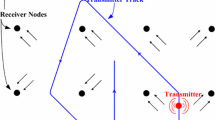Abstract
In this work, we show how a distributed sensing network consisting of very low-cost nodes can also be used to locate radio transmitters without prior knowledge of which waveform is used. This information can aid in increasing location awareness among cognitive radios, as well as provide assistance in locating offending transmitters. The low accuracy of the internal clocks of these low-cost receivers as well as the geographical distribution of the nodes result in significant challenges regarding the synchronization of the receivers in order to position the source with adequate accuracy. In this article, we synchronize the nodes to an arbitrary modulated RF signal, after which we calculate estimated time differences of arrival to an unknown transmitter. We describe the implementation as well as give results on measurement accuracy in various scenarios using a prototype network of nodes spread out in the city of Turku, Finland. In the individual distance measurements of receiver pairs, the errors in distances vary between 30 and 900 m, depending on channel conditions.









Similar content being viewed by others
Notes
References
Chen, P. C. (1999). A non-line-of-sight error mitigation algorithm in location estimation. In: Wireless communications and networking conference, 1999. WCNC. 1999 IEEE (Vol. 1, pp. 316–320). https://doi.org/10.1109/WCNC.1999.797838.
Cong, L., & Zhuang, W. (2001). Non-line-of-sight error mitigation in TDOA mobile location. In: Global telecommunications conference, 2001. GLOBECOM ’01. IEEE (Vol. 1, pp. 680–684). https://doi.org/10.1109/GLOCOM.2001.965202.
El Gemayel, N., Koslowski, S., Jondral, F., Tschan, J. (2013). A low cost TDOA localization system: Setup, challenges and results. In: 2013 10th workshop on positioning navigation and communication (WPNC) (pp. 1–4). https://doi.org/10.1109/WPNC.2013.6533293.
Enright, M., & Kurby, C. (2009). A signals of opportunity based cooperative navigation network. In: Proceedings of the IEEE 2009 national aerospace electronics conference (NAECON) (pp. 213–218). https://doi.org/10.1109/NAECON.2009.5426626.
Grönroos, S., Nybom, K., & Björkqvist, J. (2015). Synchronization of low-cost distributed spectrum sensing nodes for multilateration-based geolocation. In: Proceedings of SDR-WinnComm 2015, wireless innovation forum conference on wireless communications technologies and software defined radio (p. 223229). The Wireless Innovation Forum.
Grönroos, S., Nybom, K., Björkqvist, J., Hallio, J., Auranen, J., & Ekman, R. (2014). Distributed spectrum sensing using low cost hardware. In: Proceedings of the 2014 wireless innovation forum European conference on communications technologies and software defined radio (WInnComm-Europe 2014).
Grönroos, S., Nybom, K., Björkqvist, J., Hallio, J., Auranen, J., & Ekman, R. (2016). Distributed spectrum sensing using low cost hardware. Journal of Signal Processing Systems, 83(1), 5–17. https://doi.org/10.1007/s11265-015-1033-1.
Gustafsson, F., & Gunnarsson, F. (2005). Mobile positioning using wireless networks: Possibilities and fundamental limitations based on available wireless network measurements. IEEE Signal Processing Magazine, 22(4), 41–53. https://doi.org/10.1109/MSP.2005.1458284.
Mensing, C., & Plass, S. (2006). Positioning algorithms for cellular networks using TDOA. In: 2006 IEEE international conference on acoustics, speech and signal processing, 2006. ICASSP 2006 proceedings (Vol. 4, pp. IV–IV). https://doi.org/10.1109/ICASSP.2006.1661018.
Osmocom. (2014). OsmocomSDR (Wiki). http://sdr.osmocom.org/trac/wiki/rtl-sdr. Accessed June 13, 2014.
Qi, Y., & Kobayashi, H. (2002). Cramer–Rao lower bound for geolocation in non-line-of-sight environment. In: 2002 IEEE international conference on acoustics, speech, and signal processing (ICASSP) (Vol. 3, pp. III-2473–III-2476). https://doi.org/10.1109/ICASSP.2002.5745148.
Rabinowitz, M., & Spilker, J. J. (2005). A new positioning system using television synchronization signals. IEEE Transactions on Broadcasting, 51(1), 51–61. https://doi.org/10.1109/TBC.2004.837876.
Woodward, P. M. (1953). Probability and information theory, with applications to radar. Oxford: Pergamon Press.
Xu, J., Ma, M., & Law, C. (2007). Theoretical lower bound for UWB TDOA Positioning. In: Global telecommunications conference, 2007. GLOBECOM ’07. IEEE (pp. 4101–4105). https://doi.org/10.1109/GLOCOM.2007.780.
Yan, C., & Fan, H. (2008). Asynchronous differential TDOA for non-GPS navigation using signals of opportunity. In: IEEE international conference on acoustics, speech and signal processing, 2008. ICASSP 2008 (pp. 5312–5315). https://doi.org/10.1109/ICASSP.2008.4518859.
Zhao, Y. (2002). Standardization of mobile phone positioning for 3G systems. IEEE Communications Magazine, 40(7), 108–116. https://doi.org/10.1109/MCOM.2002.1018015.
Acknowledgements
We gratefully acknowledge the support of NVIDIA Corporation with the donation of the GeForce Titan X GPU used for this research.
Author information
Authors and Affiliations
Corresponding author
Rights and permissions
About this article
Cite this article
Grönroos, S., Nybom, K. & Björkqvist, J. Synchronization of low-cost distributed spectrum sensing nodes for multilateration-based geolocation. Analog Integr Circ Sig Process 106, 35–44 (2021). https://doi.org/10.1007/s10470-017-1094-0
Received:
Revised:
Accepted:
Published:
Issue Date:
DOI: https://doi.org/10.1007/s10470-017-1094-0




